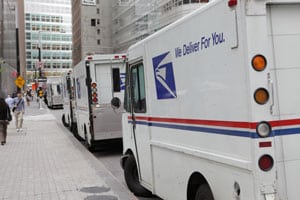 In order to keep up with major players UPS and FedEx in a hyper-competitive delivery market, the U.S. Postal Service is seeing a parcel-based future, including expansion of it grocery delivery business, a USPS executive told Multichannel Merchant.
In order to keep up with major players UPS and FedEx in a hyper-competitive delivery market, the U.S. Postal Service is seeing a parcel-based future, including expansion of it grocery delivery business, a USPS executive told Multichannel Merchant.
“We have a very structured plan around all we’re trying to do to grow our package business,” said Cliff Rucker, vice president of sales for the USPS. “When you think about it, over one-third of our volume is gone since 2006 on the letter side, so that’s why we see package delivery as a growth area.”
To that end, the USPS is moving on several fronts, including seeking $10 billion over the next four years to upgrade its aging delivery fleet and add new package sorting equipment, and requesting a nationwide expansion of its pilot run of same-day grocery delivery.
The grocery delivery request, filed Tuesday with the Postal Regulatory Commission, seeks approval of a two-year test that would expand the USPS “customized delivery” service to an unspecified number of markets. This could include grocery items – as in the current 60-day pilot of next-day delivery in San Francisco in conjunction with Amazon – or other prepackaged goods.
While not saying which markets the next-day service would expand into, Rucker said USPS is ready to go wherever customers will take them. “If a customer wants to launch in 50 markets, we’re prepared to do that,” he said. “We’re already delivering to 156 million addresses in 9,000 zip codes.” As for the San Francisco pilot, which is slated to run through mid-October, Rucker said it has “gone splendidly, and customers are happy with the service.”
According to a description of the San Francisco pilot in the PRC filing, Amazon-branded totes with QR codes for routing – some of which are chilled or include freezer packs – are delivered to local San Francisco post offices between 1:30 a.m. and 2:30 a.m., and delivered between 3 a.m. and 7 a.m. Carriers wear special lighted caps for safety during the nighttime runs, and leave the totes in locations specified by the customer as the deliveries are unattended.
Deliveries have been averaging 1 to 4 totes per address, with an average of 160 totes per day for the 38 zip codes included in the testing. A nationwide expansion of the service could bring in $10 million or more in revenue, the USPS said in its filing.
Rucker said the USPS could be more competitive on parcel shipments if there were fewer restrictions on what it could haul, such as a ban on delivering alcohol. He also said an inability to implement service to major retailers or ecommerce merchants until the contracts have been approved by postal regulators is a drag on business growth.
“A lot of things like that hinder us from moving as quickly as we’d like,” he said, adding the USPS is seeking legislative relief. “If they were removed we believe it could help us move down path toward providing better service and value to the public.”
Other aspects of the USPS’s parcel focus include seven-day-per-week delivery – again in conjunction with Amazon – and day-specific delivery guarantees on one-, two- and three-day shipping. It also includes a September rate cut that lowered prices up to 58% on certain Priority Mail packages for customers shipping at least 50,000 parcels a year, making the USPS more competitive on heavier packages. UPS and FedEx argued against approval of the rate cut, saying it was just an attempt to grab more ecommerce business, but the PRC didn’t agree.
“Our goal is to be day-agnostic in the package world,” Rucker said. “If a two-day item is mailed on a Friday, it should get there by Sunday, so two days is two days regardless. On next day, an ecommerce customer can take orders as late as midnight, drop it into our network by 7 a.m. and have a carrier deliver it that day. This gives them a longer open window for consumers to shop. For us it’s all about driving value.”
